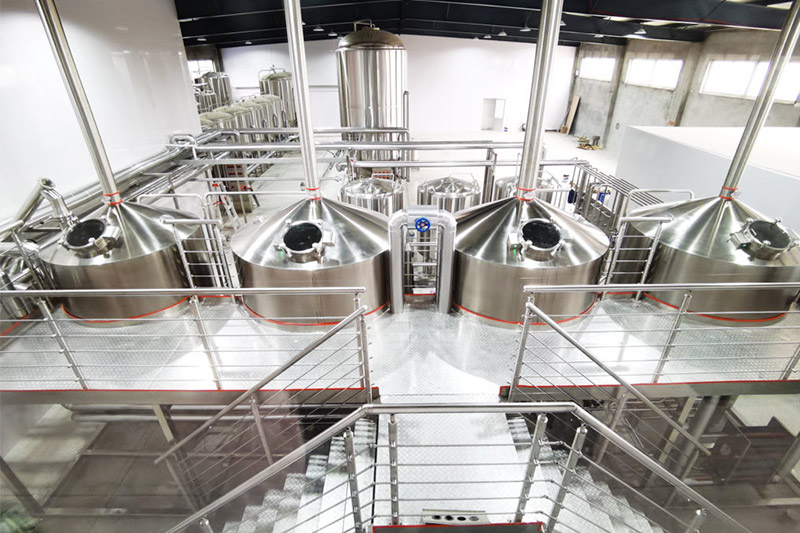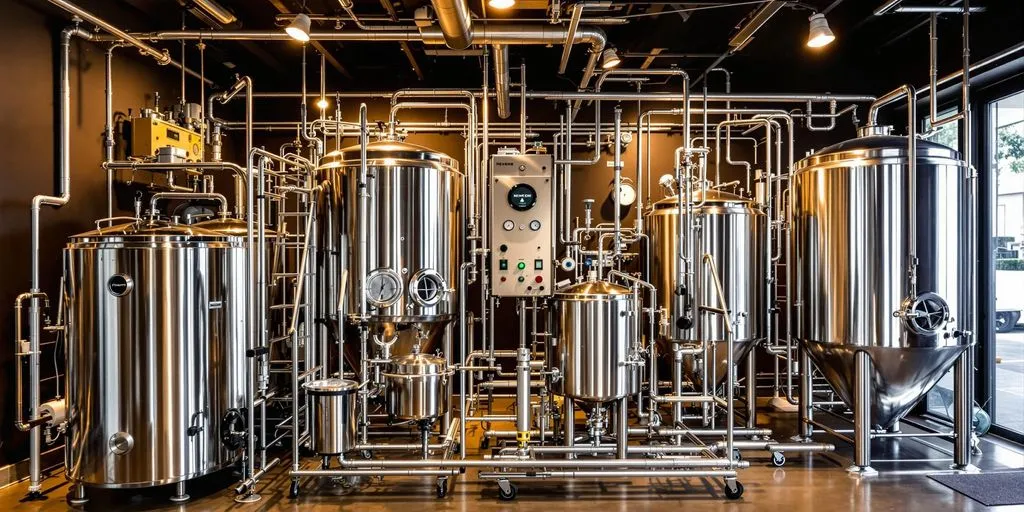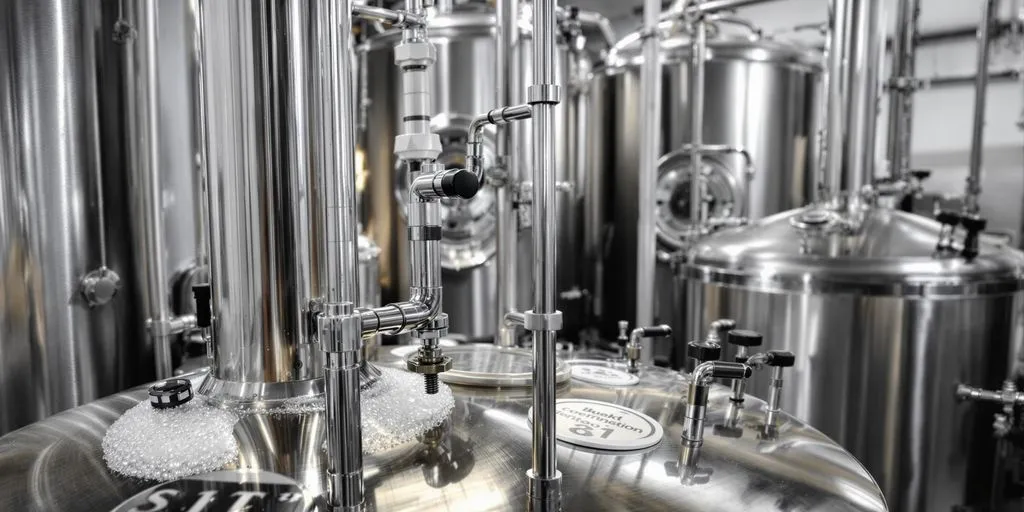Are you a beer lover dreaming of creating your very own craft beer at home or on a larger commercial scale? Or perhaps you run a brewery and want to upgrade to more efficient and reliable brewing merchandise? If so, you’re in the right place. This guide explores everything about beer brewing equipment, from stainless steel kettle choices to advice on the ideal fermenter for consistent fermentation. Whether you want to brew beer for small batches of beer or invest in an all-in-one system, this article will give you the knowledge to make the best decisions. So grab a pint, read on, and discover how to produce quality beer using the right equipment according to your needs.

1. How to Start Your Brew: Understanding the Basics
Before you begin to brew beer, you should grasp key concepts like wort, fermentation, hop additions, and the role of yeast. Creating a consistent batch of beer requires a reliable process and the right equipment. Whether you’re exploring your first beer making steps at home or ramping up for a commercial brewery expansion, this foundation applies to everyone.
The Role of Home Brew in Beer Culture
There’s something deeply satisfying about homebrewing your own batch. With a home brew setup, you can experiment with flavors, mash schedules, and yeast varieties. Over the last decade, interest in homebrewing soared, with many craft beer enthusiasts using small batches to refine recipes. Even craft breweries started in someone’s garage or basement, after all.Fun Fact: The best beer sometimes emerges from tinkering in a modest home brewing environment, eventually scaling up to become a nationally recognized brand.
The Growth of Craft Beer
It’s no secret that craft beer remains one of the fastest-growing segments in the global beverage sector. People crave variety and unique tastes compared to mainstream lagers. This desire for distinctive brews fuels the need for quality beer brewing equipment. Whether it’s a small brew pub or a mid-sized commercial brewing operation, the right approach to brew helps you create a premium beer that stands out.
2. Which Brewing Equipment Suits You Best?
Selecting the right equipment depends on your production goals, type of recipes, and budget. For home brewing equipment or advanced brewery expansions, you should research key components: a stainless steel kettle, fermentation tank, brite tank, and more.
Essential Gear for Startups
- Kettle: Typically made of 304 stainless steel for durability and easy cleaning. The stainless steel kettle is where you boil wort.
- Fermenter: Could be a conical fermenter that allows yeast to settle.
- Keg or Bottling Setup: Once you complete the brewing process, the next step is storing your final product.
- Temperature Control: Thermometers, glycol chillers, or jacketed fermenters to ensure a stable environment for fermentation.
Upgrading to Commercial Beer Brewing Equipment
If you’re scaling from small batches to a more commercial brewing format, you’ll likely need a bigger brewhouse, multiple fermentation vessels, a CIP system, and advanced brewing systems. This ensures you can keep up with the volume and maintain consistent quality across every batch. Contact micet craft to get thorough advice on scaling from small to large operations.(Want a closer look at advanced gear? Explore commercial-brewery-equipment for an overview of large-scale solutions. These setups handle everything from mash to packaging, offering tailored solutions for breweries all over the world.)
3. Why Invest in Quality Beer Brewing Equipment?
Crafting Quality Beer at a Time
Some say beer is mostly about artistry, but the truth is that the right equipment drastically impacts your results. Having well-designed beer brewing equipment can help ensure that each batch of beer ferments at the ideal temperature. A well-constructed kettle prevents scorching your wort. Using spring-loaded clamp fittings might avoid leaks or contamination. The outcome? A consistent, best beer product.
Longevity and Return on Investment
From stainless steel to well-engineered keg washers, quality hardware lasts for decades. Over time, your capital outlay on robust brewery equipment or advanced microbrewery equipment pays off in reduced downtime, minimal repairs, and stable production. Also, equipment designed for industry standards means less upgrade hassle as you scale up.(Our nano-brewery-equipment is a prime example of a portable, entry-level system for craft brewers or R&D labs. Start small, but with professional-grade components. When you’re ready, you can build up to bigger kettles, hoppers, or a large brite tank.)
4. What Is the Brewing Process All About?
Brewing is a series of stages: heating water, mashing grains, boiling the wort, adding hop, cooling, pitching yeast, and waiting out fermentation. Then you carbonate the product for that crisp fizz.
Key Steps in the Brewing Process
- Milling & Mashing: Cracked malt interacts with heated water in the mash tun to extract sugars.
- Lautering & Sparging: Sugar-rich wort is separated from the grain husks. Additional water flushes more sugars out.
- Boiling & Hop Additions: Boiling ensures sanitization and hop alpha acid isomerization.
- Cooling & Fermentation: Transfer the cooled wort to a fermentation tank or conical fermenter, add yeast, and let it ferment typically for days or weeks.
- Conditioning & Packaging: Brite tank, keg, or bottles can carry your final product to the masses.
Stat: Good brewery practices and advanced temperature control can cut fermentation process time by up to 20%, letting you produce more beer at a time.
5. How Does Temperature Control and Fermentation Work?
Importance of Fermentation Vessel and Temperature
During beer fermentation, consistent temperature is crucial. Each yeast strain thrives in a specific range. If it’s too high, the brewer risks producing unwanted off-flavors. If it’s too low, the batch might stall, leaving residual sugars and a sweet taste. Tools like glycol chillers, digital controllers, or jackets on fermenters let you dial in perfect conditions.
Tech Solutions for Modern Brewing
From the conical fermenter with builtin sampling ports to automated temperature readouts, technology helps you manage the process more precisely. This leads to more consistent small batches, better quality beer, and fewer expansions lost from guesswork.(Check out beer-brewing-equipment for an array of solutions covering everything from temperature-regulated mash tuns to advanced conical fermenters. With these, you can refine your brewing experience step by step.)
6. Why Mash and Tun Are Crucial Core Components?
The Mash Tun’s Role
One of the earliest steps is mash—the process of steeping milled grains in hot water. This typically occurs in a mash tun, sometimes part of an all-in-one or modular brewhouse system. By carefully controlling time and temperature, you release fermentable sugars. Good mash tun design helps maintain consistent heat, which is essential for stable sugar extraction.
Balancing Temperatures and Minimizing Heat Loss
Brewing is partly about capturing the perfect enzyme activity. If your system can hold temperatures within a narrow range, you’ll get a more predictable batch. Modern tun vessels use insulation and built-in recirculation. If you aim for an upgrade, look for double-jacketed designs in 304 stainless steel, known for reliability and cleanliness.(Need an in-between solution? The 2-vessel-brewhouse merges mashing and boiling in fewer vessels, perfect for craft brewers seeking efficiency and streamlined footprints.)

7. Should You Go Electric Brewing or Stick to Classic Methods?
Overview of Electric Brewing
Electric brewing systems rely on immersion heaters or external heating elements inside the kettle. They’re popular among homebrewing enthusiasts for convenience or in smaller brew pubs where direct gas lines aren’t feasible. The advantage is precise temperature control with minimal emissions or heat loss.
Gas-Fired vs. Electric-Fired
Gas-Fired: Quicker heat response, often used in large or commercial brewing setups. Might require additional ventilation.
Electric-Fired: Safer for indoors or smaller home brewing equipment, can be less messy, though might heat slower based on wattage.(Eyeing further expansions? The beer-brewing-system from Micet suggests multiple power source options—gas, electric, or steam—to provide the best fit for your scale and space availability.)
8. Which Brewing Kits Are Perfect for Beginners?
Must-Have Equipment for New Brewers
If you’re new to beer making, a beer making kits approach can be a great way to get your feet wet. These brewing kits often include a small kettle, fermentation vessel, and basic brewing supplies. The all-grain method might require more steps but yields better flavor control. Extract-based kits are simpler but might compromise complex malt profiles.Equipment Needed to Start:
- A kettle big enough for your typical batch of beer
- A fermenter (could be a plastic bucket or conical)
- Bottling or keg equipment
- Temperature control devices, like a stick-on thermometer or immersion chiller
Step Forward to Mastery
After you get comfortable, you might want to upgrade your gear to produce bigger volumes or explore new beer styles. Tools like a mash tun, brite tank, or automated stirring arms can help you refine your small batches of beer or attempt a commercial beer brewing equipment step if you want to serve a local community.(Looking for a mid-range jump from kits to real micro operations? Our microbrewery-equipment is designed and manufacture solutions specifically aimed at bridging that gap, giving you a complete turnkey solution in one package.)
9. FAQs
It depends on your production goals, budget, and desired beer style. If you want to beer at home, home brew kits might be enough. If you want to produce in bigger volumes, consider commercial beer brewing equipment. Please pay attention to your available space, power source, and typical batch volume.
Absolutely. The same base system can produce IPAs, stouts, lagers, sours, and more. The main difference lies in temperature control for fermentation, yeast selection, and hop schedules. This adaptability explains why so many craft brewers rely on universal gear for a wide selection of recipes.
A brite tank is a specialized vessel used after fermentation tank to clarify and carbonate the beer. If you want crisp, clear beer, the brite stage can help remove suspensions. Many craft beer brewing setups use a brite tank for final finishing. This might be optional for ultra-small operators but vital for those producing consistent premium beer.
Stainless steel is known for its durability, but routine cleaning is mandatory. Using a CIP (clean-in-place) system or a mild detergent prevents build-up. Rinse thoroughly to remove any chemical residue that might affect flavor. Fitting the correct CIP spray ball also helps to scrub challenging areas in the kettle or fermenter.
The fundamentals remain the same: mash, boil, hop additions, ferment, condition. However, beer production at large scale (like a beer brewery) often demands more advanced brewing systems for heat exchanges, advanced CIP, and temperature controls.
10. AIDA: Turning Knowledge Into Action
A (Attention)
We are craft beer equipment Manufacturing plants for products, providing comprehensive solutions for beer making. Tired of searching for equipment to 100 percent meet your needs? We create systems that range from home brew kits to commercial brewing setups—so you can brew with confidence.
I (Interest)
Picture yourself or your brewers all over the world sipping the fruit of your labor: flavorful, quality beer. Our 304 stainless steel tanks, advanced mash tun, or conical fermenters bring your dream to reality. By harnessing brewing systems and the right technology, you get professional results each time.
D (Desire)
Imagine seamless brew days with minimal cleanup. Our stainless steel kettle prevents scorching. Our fermenter with robust temperature control ensures consistent fermentation. Best of all, you can upgrade your gear along with your business growth. We have a wide selection of solutions for both home brew enthusiasts and commercial brewing experts.
A (Action)
Ready to produce small batches or scale up to feed local craft breweries? Contact micet craft now. We have the equipment designed to cater to your needs—offering tailored solutions for brewery equipment, from beer fermentors to brite tank, and more. We provide the best service so you can produce the premium beer you’ve always wanted. Whether you want a complete turnkey solution or just one vessel, we’re here to help. Please pay attention to your next steps, so your beer at home or commercial success is guaranteed.
(Caption: A typical stainless steel brew setup—kettles, fermenters, and more—designed to produce consistent, high-quality beer. Perfect for small batches or commercial expansions.)
5-6 Relevant Internal Links
- Explore nano-brewery-equipment if you’re looking to test unique recipes or brew smaller volumes.
- For mid-sized expansions, check out microbrewery-equipment that can handle more frequent batches without losing flexibility.
- Larger operations can consider commercial-brewery-equipment to streamline the entire operation, from milling to packaging.
- If you specifically desire advanced designs, see beer-brewing-equipment for in-depth details on everything from CIP arms to temperature control manways.
- Our specialized beer-brewing-system merges everything you need—mash, lauter, boil, whirlpool—into a cohesive unit for the ultimate synergy.
11. Conclusion & Key Takeaways
Below are vital points to remember as you embark on your brewing journey:
- brew your own style with confidence, whether in a small garage or a large brewery.
- brewing equipment choices—kettle, fermenter, brite tank, keg—directly impact final flavor and consistency.
- beer brewing fundamentals revolve around mash, wort, fermentation, hop additions, and temperature control.
- beer making can remain a hobby using home brew gear or transform into a business with commercial beer brewing equipment.
- beer brewing equipment comes in many scales; pick carefully between bench-top or full brewhouse solutions.
- craft beer demand is soaring, so having the right equipment and approach can yield profitable success in local or global markets.
- brewer success often depends on stable, well-maintained gear from stainless steel kettles to advanced fermentation tanks.
- contact micet craft for offering tailored solutions that fit your brew scale, from all-grain home kits to 10,000L industrial lines.
- 304 stainless steel, sturdy welds, and CIP-friendly designs ensure a longer lifespan and safer ferment.
- We design and manufacture a complete turnkey solution for those seeking to upgrade or start from scratch.
With the knowledge above, you’re well on the path to creating superb craft beer brewing experiences for yourself, your customers, or your beer lover friends. When you pay close attention to each detail—like the fermentation process, all-grain approach, or even the fitting of your CIP arms—your final product will speak volumes of craftsmanship. Raise a glass to success as you harness the power of equipment needed to start, do small or big batch, and produce the best possible taste. Cheers!

